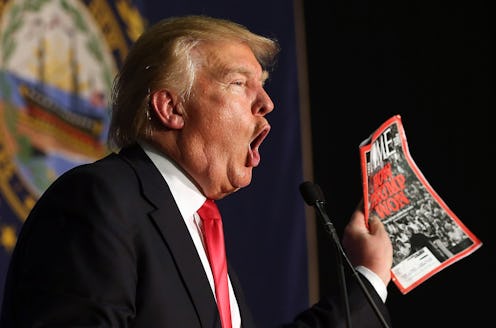News
'TIME' Has A New Donald Trump Message
As the presidential race carries on, layers and layers of Donald Trump's campaign have peeled away to reveal a candidate who seems to only be consistent in his flip-flopping on the issues. But TIME Magazine, who has covered Donald Trump for years, seems to also be unable to firmly decide what it thinks of him. Its coverage of the mogul has been exhaustive, dating back to his early real estate days in the '70s. But as Trump's position in American culture has evolved, so has TIME's perception of him. Has the magazine contributed in any way to the overall American consensus of Trump, whether good or bad?
The magazine's first reporting on Trump came in the late 1970s, when there were no talks of presidential bids or border walls. TIME stuck to the facts as they were back then — he was a Manhattan socialite involved in the development of New York's high-rise real estate. He wouldn't truly burst onto the scene until some years later, with TIME labeling him a "tycoon" shortly after it featured a segment on his Trump Tower in 1981. And as we know, that first label has only evolved into many other, much more terrifying ones over time.
The tycoon-turned-demagogue landed his first full story with the magazine in 1984, which offered glimpses into the man the world would one day not be able to ignore. During this story, Trump talked of his recently-purchased football team, the New Jersey Generals. After purchasing the team, the Generals had finally shaken their losing streak, to which Trump had remarked: "[They have] become the number one story in the whole of sports." TIME writer John Demott said that language like this was "part of the Trump style," and later told readers that Trump "cannot recall ever failing at anything, nor does he even entertain the possibility."
At the time, Trump had already collected his fair share of critics, but the magazine remained neutral on the rising figure. It wasn't until TIME gave Trump his own cover in 1989 that it seemed to take a stand in favor of the businessman. That cover story hinted at Trump one day running for president, but called the possibility unlikely. But it seems like this article captured his appeal; a prediction of the future that turned out to be all too true:
At 6 ft. 2 in., real estate tycoon Donald J. (for John) Trump does not really loom colossus-high above the horizon of New York and New Jersey. He has created no great work of art or ideas, and even as a maker or possessor of money he does not rank among the top ten, or even 50. Yet at 42 he has seized a large fistful of that contemporary coin known as celebrity. There has been artfully hyped talk about his having political ambitions, worrying about nuclear proliferation, even someday running for President. No matter how farfetched that may be, something about his combination of blue-eyed swagger and success has caught the public fancy and made him in many ways a symbol of an acquisitive and mercenary age.
Flash-forward to present day, and we can see how TIME's coverage of the GOP front-runner has changed with the evolving perception of him, both nationally and abroad. He was next placed on the cover more than 25 years later, in August 2015, which featured the blunt headline "Deal With It." The magazine has skirted a fine line — while a good majority of media coverage regarding Trump has been negative, TIME more or less praised him. Writer Michael Scherer said:
When he says he will beat China, steal Iraq’s oil and stick it to Iran, he is selling an unlikely dream. But that, after all, is what campaigns are about. “I’m just as disappointed with the Republicans as I am the Democrats,” Trump says. “It’s just so false and so phony and they can’t move—it’s moribund. They become weak and ineffective, except with one thing, getting themselves re-elected. That’s the one thing they’re good at.” Preach.
Scherer's use of "preach" to cap Trump's statement suggests at least some level of agreement with the candidate. The editors of the magazine seemed to carry on in this same direction months later, when it shortlisted Trump on its coveted "Person of the Year" list. He was given third place on the list, behind German Chancellor Angela Merkel and Islamic State of Iraq and Syria leader Abu Bakr al-Baghdadi.
Trump's impact on United States politics is undeniable. To remove him from the list entirely, however, might have been a bolder move than placing him in the top three. His absence could have sparked a conversation regarding his viability as a candidate. Instead, he was rewarded with more borderline-positive publicity from the magazine.
The March 14 cover is more critical of the candidate. It calls him a "bully" and "party crasher," though it still leaves room for the possibility of the title of "President of the United States." It would be coming a long way from the magazine's first label, "tycoon."
TIME cannot be held responsible for The Donald's current position, but the magazine has certainly had a hand in making the candidate more visible as far back as the 1970s. Trump already seems to be visible enough on his own, though, and through its repeated cover stories on him and his third-place standing in the "Person of the Year" shortlist, it looks as though TIME may be making certain the public will continue seeing the candidate on newsstands long past what he might deserve.
Images: TIME
